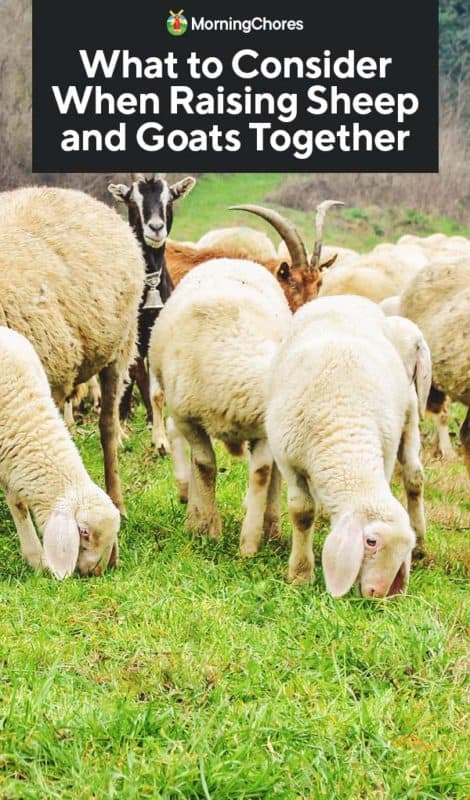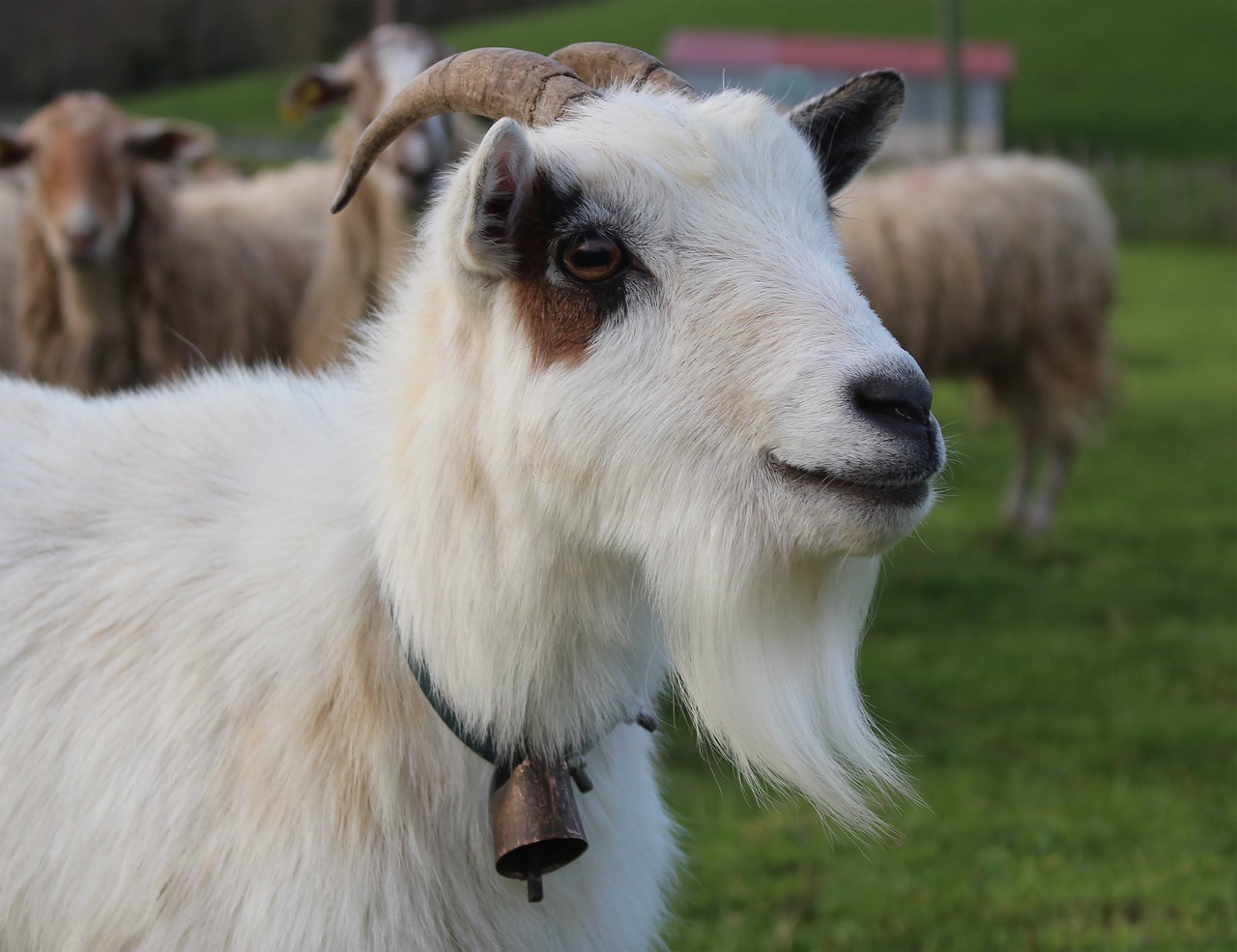Whether you’ve just begun raising animals on your small farm or you’ve been doing it for some time, you may ask yourself whether certain species of animals can be housed and raised together.
There are some animals that you would never want to raise in close proximity to each other – think sheep and pigs. However, with some, like sheep and goats, the answer is a bit more ambiguous.
Many people wonder if sheep and goats can be raised together because the two species have so much in common. As small ruminant animals that can be raised for meat, milk, and wool, they seem to have a lot in common.
In most cases, it’s fine to raise the two together – but there are some key considerations you will need to make before you take the leap.

Is it Possible to Keep Sheep and Goats Together?
Wondering whether you can raise sheep and goats together? In most cases, absolutely. This practice is best if you just have a small number of each species but not as easy if you raise either species commercially or in large numbers.
Raising sheep and goats together requires some special consideration. Generally, it’s fine to keep them together as long as the sheep are polled (lacking horns) and the goats have been disbudded, too.
As members of the Bovidae family and Caprinae subfamily, sheep and goats have a lot of physiology in common and are relatively docile – you shouldn’t have to worry about any violent displays between the two.
But as with all things, you will need to do some planning. Here’s what you need to keep in mind.
Important Things to Consider
1. Feeding
The most important consideration is that of feeding. Both goats and sheep are ruminants. This means that they are herbivores with special stomachs that have four compartments.
The rumen essentially acts as a large fermentation tank, breaking down grasses and other plants into usable nutrients.
Goats and sheep will both be able to graze in the same pasture. Goats are browsers, preferring to eat grass, leaves, trees, shrubs, and brush. Sheep, too, like grass and broad-leafed plants.
In fact, when the two species are used in conjunction, they can actually produce quite an effective pasture management plan. The goats will eat things that the sheep won’t, and vice versa. There shouldn’t be too much competition for food.
However, what’s tricky when it comes to feeding is the supplementation. Both sheep and goats require mineral supplements along with forage, hay, and grain. However, goats need a mineral supplement that contains copper. Sheep do, too, but in minutely small amounts – and too much copper can be fatal.
In most cases, sheep acquire their needed materials through foraging alone. If you have a way to isolate your goats’ mineral supplement blocks or feeders from your sheep, you can make sure your goats get the copper they need without poisoning your sheep.
Since goats love jumping onto structures, keeping the mineral block on top of specially built goat play-area would keep it out of reach of the sheep.
2. Housing
To keep your animals protected from the elements, you need to make sure you have solid housing in place – this is true for both goats and sheep. In general, a three-sided shelter is fine for both species. Just keep in mind that while sheep prefer shelter on hot days for the shade, goats will require shelter during cold or rainy seasons instead.
Also, you will need to be careful about your fencing. Sheep are pretty obedient when it comes to minding fences and other perimeters. The main goal of fencing with sheep is to keep predators out – net wire or woven fence is fine.
However, you’ll want to stay away from these options with goats because they can easily maneuver their way out. Goats are natural explorers and escape artists, so you will need to erect a stronger, more impervious fence.
If you are raising one species for dairy production (both goats and sheep can be raised for milk) keep in mind that you will be calling some animals into the barn to be milked twice a day. This can be a challenge if you have two separate species in the same living quarters, but not any more challenging than if you had dry ewes or does in a dairy herd or flock, anyway.
3. Conflicts
Both sheep and goats are sociable animals, meaning they compete with one another for spots in a herd. While sheep and goats will usually ignore each other, they may get confused and try to compete.
If you decide to raise sheep and goats together, do yourself a favor and select animals without horns. Both sheep and goats can have horns, but you can choose polled varieties of sheep or disbud your goats to eliminate these.
The reason you need to do this is that goats and sheep are both social species that will compete with each other for their rightful spots in the herd. During times of intense competition, such as mating seasons, this can become dangerous as the two species may injure each other with their horns.
Similarly, you should keep lambs and kids with their mothers away from horned animals during the first few weeks after birth. This will help prevent potential injury risks.
4. Disease
One of the most common reasons as to why experts advise against keeping goats and sheep together is because they can carry the same diseases.
However, this is a moot point if you a) have a good disease prevention plan in your herd or flock and b) are keeping more than one animal anyway. After all, what’s the difference between two goats catching a disease versus a goat and a sheep getting sick?
Make sure you practice good pasture management practices, such as rotational grazing areas every few weeks. Deworm your animals and make sure you administer all the necessary vaccinations to prevent disease. If you bring new animals to the farm, make sure they’re healthy first.
Both goats and sheep are susceptible to hoof rot – this occurs when the ground is wet for long periods of time. Make sure you practice good hoof hygiene by offering dry shelters and trimming your livestock’s hooves as needed.
If you’re used to only raising goats and are now adding sheep, you may be surprised to hear that your sheep will be more likely to suffer from internal parasites. This is because sheep tend to eat closer to the ground and will rapidly overgraze a pasture, making them more susceptible to heavy parasite loads. Goats, on the other hand, will browse over a wide territory.
5. Interbreeding
Ever heard of a geep? It’s not a misspelling of “Jeep.” No, a geep is a sheep and goat that have been bred together.
This is problematic. FIrs of all, goats and sheep are different species. Goats have 60 chromosomes while sheep have 54. The two species can mate, but this is rare – and unnatural. Geeps typically die at birth or end up being infertile.
Again, this is uncommon – but to reduce your risk, isolate the bucks and rams in separate pens with their respective females. This will help reduce potential aggression when your sheep and goats are breeding separately, too.
The Benefits of Raising Sheep and Goats Together
Most people don’t raise sheep and goats together simply because they don’t need to. Goats and sheep are different animals and communicate with each other in different mannerisms. While goats rear up on their hind legs and sheep put their head down prior to displays of aggression, both have their own unique methods of communication.
And to be fair, both goats and sheep are distinctly different species. But that doesn’t mean you can’t raise them together in semi-harmony. Raising these species in the same pasture or paddock not only saves space, but it can save some time, too. Instead of putting out a separate bale of hay or water drinker in two separate enclosures, you can just put out one for both.
Again, raising sheep and goats together is only recommended if you don’t have a ton of animals to take care of. Raising large quantities of these different species together can cause some issues in flock/herd management, plus it can lead to some hierarchical issues among the goats and sheep.
The Challenges of Raising Sheep and Goats Together

Most of the time, you aren’t going to have any issues raising goats and sheep together, and the two can actually work together in harmony to clear a plot of land for you. Plus, goats act as good predator deterrents for sheep, as they tend to be more boisterous and aggressive than sheep, especially young lambs.
While you do need to keep in mind the issues of disease management and potential sheep copper toxicity risks, it’s ultimately not terribly difficult to keep the two together. Whether you’re hoping to save space or just a little bit of time on your daily feeding chores, rest assured knowing that you won’t be putting any of your animals’ lives at risk by doubling up on the housing.
Just make sure you heed the tips we mentioned above. Nine times out of ten, your goats and sheep will probably ignore each other – and your workload will be a lot lighter.
